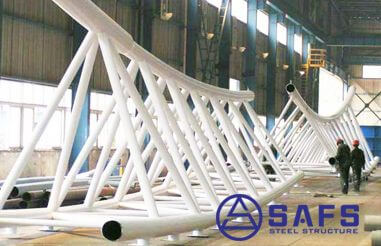Dapeng Town Industrial Park, Tongshan District, Xuzhou City, Jiangsu Province, China
In daily life, we often see many large public facilities, some of which are built using truss structure. Truss construction is relatively simple and convenient, and the cost is lower than that of grid. In this article, we will understand the design characteristics and application common sense of truss structure from several dimensions.
The main characteristics of truss structure: high structure height and light weight; relatively stable compression chord; unidirectional force (grid structure is bidirectional force).
The role and characteristics of truss structure:
Upper chord and lower chord: bear axial force caused by bending moment;
Web member: bear shear force caused by bending moment;
Reasonable web member arrangement, try to be tensile (mainly considering the problem of stability coefficient).
Comparison of the characteristics of two-dimensional truss and space truss:
Two-dimensional truss: the number of upper and lower chords is the same, and the cross section of the tension lower chord will be smaller;
Space truss: strengthen the compression area and enhance overall stability.

Advantages and disadvantages of three-dimensional truss structure:
Advantages:
The overall rigidity of the structure is large and the stability is good;
It can realize on-site layered hoisting, and the construction difficulty is relatively small;
It can better realize the layer effect of this building.
Disadvantages:
There is a large horizontal thrust on the columns on both sides
Force characteristics of truss structure:
All external forces act within the center plane of the truss and are concentrated on the nodes;
From a mechanical perspective: when the truss shape is similar to the bending moment diagram of the simply supported beam, the distribution of the axial forces of the upper and lower chords is uniform, the axial force of the web is small, and the material is relatively economical;
From a material and manufacturing perspective: steel trusses are generally trapezoidal or parallel chordal, and reinforced concrete and prestressed concrete trusses are polygonal or trapezoidal;
Height and span: 1/12~1/16 for three-dimensional trusses, 1/20~1/30 for three-dimensional arch frames, and 1/30~1/50 for tensioned three-dimensional arch frames.
There are many places where trusses can be used in real life, too numerous to mention; determine the specific form, material and support method of the truss according to the actual use of the scene and needs, and determine the best form after comprehensive consideration of multiple dimensions, which can also save more energy and labor costs for the project.